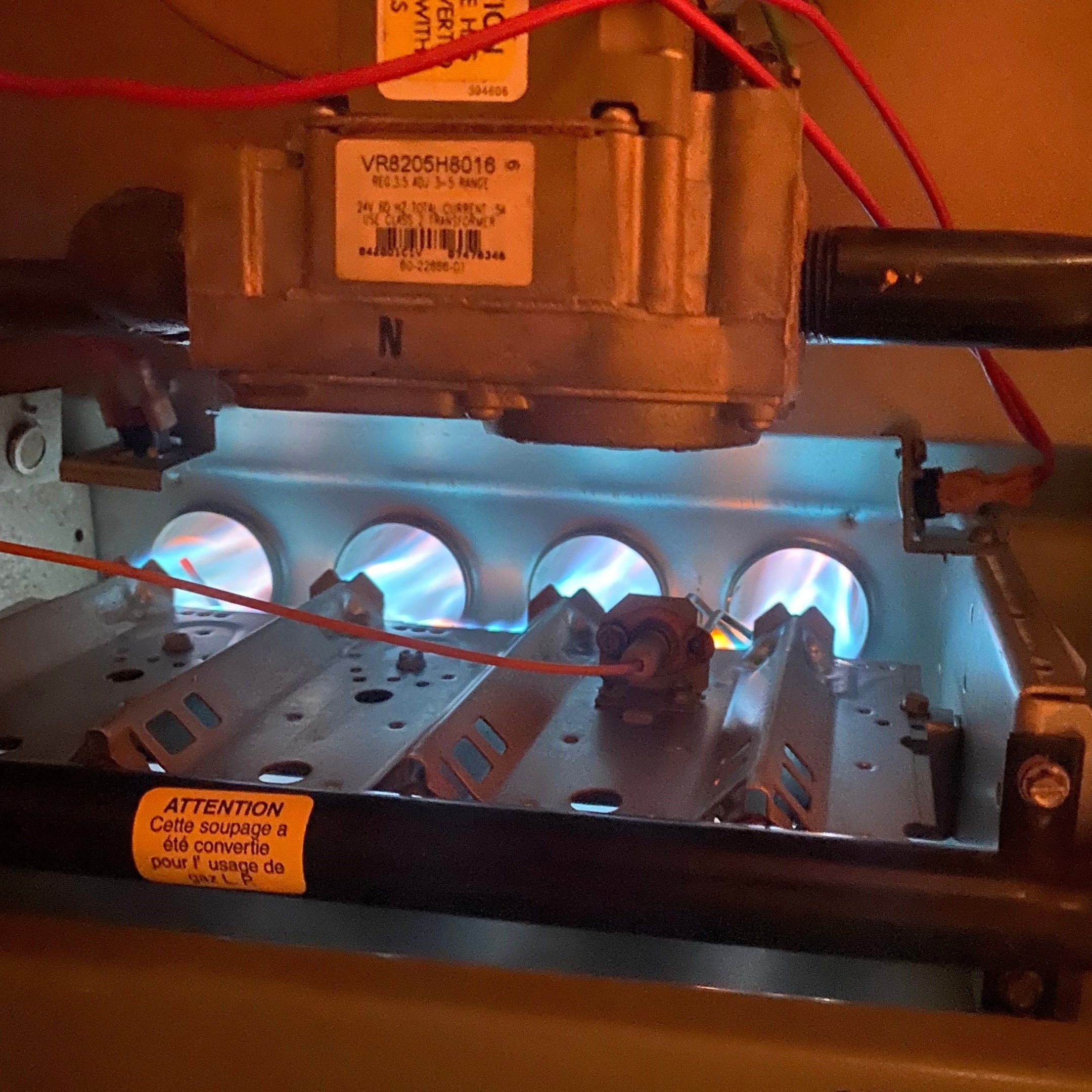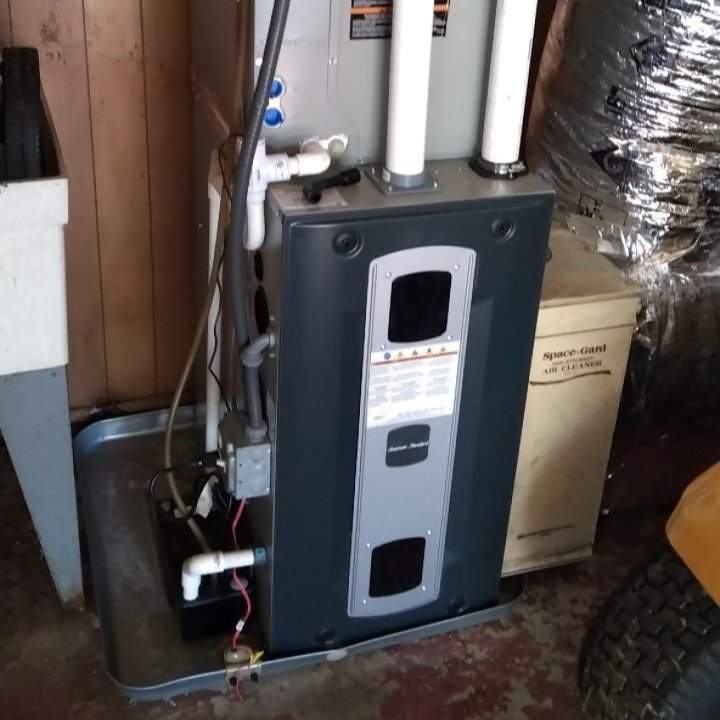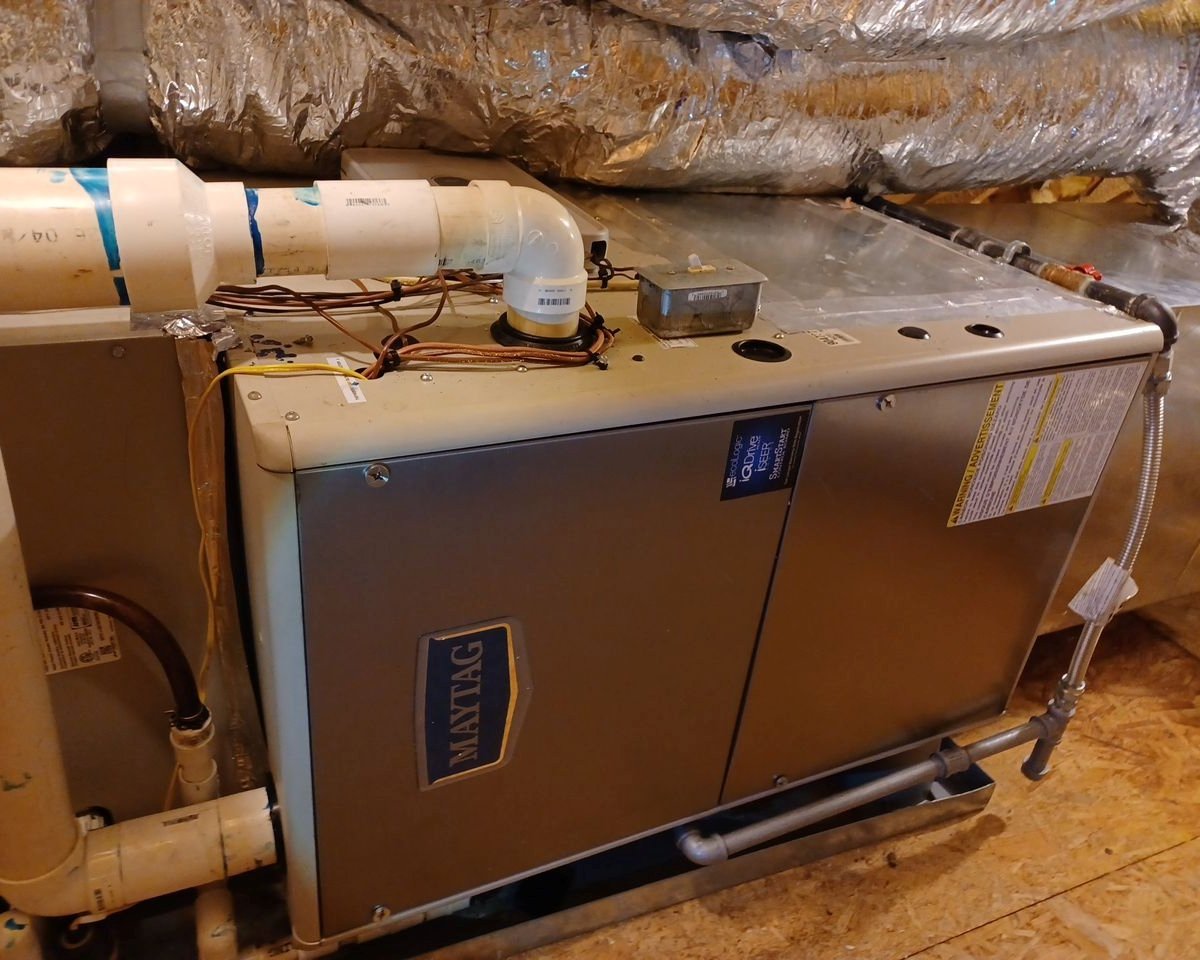Gas Furnaces
What You Need to Know
Gas furnaces are a common type of heating system used in many homes and buildings. Here are some key things you need to know about gas furnaces:
How They Work:
Gas furnaces burn natural gas or propane to produce heat.
The combustion process takes place in the furnace's burner, and the heat is then transferred to the air through a heat exchanger.
The blower fan circulates the heated air through ducts and vents, distributing it throughout the building.
Efficiency Ratings:
Gas furnaces are rated for efficiency using the Annual Fuel Utilization Efficiency (AFUE) metric, which indicates the percentage of fuel that is converted into heat. Higher AFUE ratings represent more efficient furnaces.
High-efficiency models typically have AFUE ratings of 90% or above.
Types of Gas Furnaces:
There are two main types of gas furnaces: single-stage and two-stage.
Single-stage furnaces have only one heat output setting and operate at full capacity whenever they are turned on.
Two-stage furnaces have two heat output settings, allowing for a more gradual and energy-efficient heat delivery.
Maintenance:
Regular maintenance is crucial for the efficient and safe operation of a gas furnace. This includes cleaning or replacing air filters, checking the pilot light, and inspecting the heat exchanger for any cracks.
Annual professional inspections can help identify and address potential issues before they become major problems.
Safety Considerations:
Gas furnaces produce carbon monoxide as a byproduct of combustion. It is important to have a functioning and well-maintained venting system to safely remove these gases from the home.
Carbon monoxide detectors are essential for early detection of any leaks, providing an additional layer of safety.
Thermostats:
Gas furnaces are typically controlled by a thermostat, which allows users to set the desired temperature for their home.
Programmable thermostats offer the ability to schedule temperature changes, improving energy efficiency.
Installation and Sizing:
Proper installation and sizing of a gas furnace are crucial for optimal performance. An oversized or undersized furnace can lead to inefficiency and comfort issues.
Professional installation by a qualified technician is recommended.
Cost Considerations:
The initial cost of a gas furnace includes the unit itself, installation, and any necessary ductwork modifications.
Although gas furnaces can be more expensive upfront compared to electric heaters, they often have lower operational costs.
Energy Source:
Gas furnaces require a natural gas or propane supply. Ensure that your home is connected to the appropriate gas source before considering a gas furnace.
Environmental Impact:
Burning natural gas releases carbon dioxide, contributing to greenhouse gas emissions. High-efficiency models can help reduce the environmental impact by maximizing fuel efficiency.
Always consult with a qualified HVAC professional for advice on selecting, installing, and maintaining a gas furnace for your specific needs.
Why Invest in a Gas Furnace?
Investing in a gas furnace can offer several benefits, making it a popular choice for heating in many homes. Here are some reasons why people choose to invest in gas furnaces:
Cost Efficiency:
Gas furnaces are often more cost-effective to operate compared to electric heating systems. Natural gas and propane, the fuels used by gas furnaces, are often less expensive than electricity on a per-unit basis.
Energy Efficiency:
High-efficiency gas furnaces are available with AFUE ratings of 90% or higher, meaning that a significant portion of the fuel is converted into usable heat. This efficiency can result in lower energy bills and reduced environmental impact. Be sure to check your furnace for Energy Star ratings.
+90% AFUE Gas Furnace
Quick and Energy Efficient Heating:
Gas furnaces can heat a home quickly, providing a fast response to temperature adjustments. This is especially beneficial in colder climates where rapid heating is essential for comfort.
Consistent and Even Heating:
Gas furnaces can distribute heat more evenly throughout a home, reducing temperature fluctuations and providing a consistent level of comfort.
Reliability:
Gas furnaces are known for their reliability and durability when properly maintained. They can provide consistent heating for many years with regular inspections and maintenance.
Compatibility with Thermostats:
Furnaces can easily be integrated with programmable thermostats, allowing users to set and schedule temperature adjustments based on their preferences and daily routines.
Independence from External Factors:
Unlike electric heating, which can be affected by power outages, furnaces operate independently of the electrical grid. This can be advantageous during severe weather conditions when power disruptions are more likely.
Environmental Considerations:
While the combustion of natural gas does produce carbon dioxide, high-efficiency furnaces can minimize emissions by maximizing fuel efficiency. Additionally, advancements in technology continue to improve the environmental impact of gas heating systems.
Long-Term Savings:
Although the upfront cost of a gas furnace and installation may be higher than some alternatives, the long-term operational cost savings can make it a financially sound investment over time.
Home Resale Value:
Homes equipped with furnaces may have higher resale value, as many buyers appreciate the efficiency, reliability, and cost savings associated with this type of heating system.
It's important to consider factors such as the availability of natural gas or propane in your area, the efficiency of the furnace, and your specific heating needs when deciding whether to invest in a gas furnace. Consulting with HVAC professionals can help you make an informed decision based on your home's requirements and your long-term goals.
The Upfront Cost and Installation
Tight attic spaces can additional cost to installations
The upfront cost and installation of a gas furnace can vary depending on several factors, including the type of furnace, its efficiency, local labor rates, and any additional requirements specific to your home. Here are some considerations regarding the upfront cost and installation of a gas furnace:
Furnace Cost:
The cost of the gas furnace itself is a significant component of the upfront expense. High-efficiency models with advanced features typically come at a higher price. Basic single-stage furnaces are generally less expensive than staged or modulating furnaces.
Efficiency Ratings:
Higher-efficiency furnaces with better AFUE ratings often come with a higher price tag. However, the increased efficiency can result in long-term energy savings.
Installation Costs:
The installation costs include the labor charges for a qualified HVAC technician to install the furnace. This involves connecting the furnace to the gas supply, installing the venting system, and integrating the furnace with the existing ductwork.
Ductwork Modifications:
If your home's ductwork is not compatible with the new furnace or if modifications are needed, additional costs may be incurred. Proper duct sizing and sealing are crucial for the optimal performance of the gas furnace.
Permit Fees:
Depending on local regulations, you may need to obtain permits for the installation of a new gas furnace. Permit fees can vary by location.
Venting Requirements:
Venting systems for furnaces need to comply with safety standards. If modifications or upgrades to the venting system are necessary, it can contribute to the overall installation cost.
Location and Accessibility:
The physical location of the furnace installation and its accessibility can impact installation costs. For example, if the installation requires additional labor due to tight spaces or other challenges, it may increase the overall expense.
Professional Installation:
It's crucial to have the gas furnace installed by a qualified and licensed HVAC professional. Professional installation ensures the system's safety, efficiency, and compliance with local codes.
Warranty and Guarantees:
Consider the warranty offered by the furnace manufacturer and the installation contractor. A longer warranty period can provide peace of mind and potentially reduce repair costs in the future.
Financing Options:
Some HVAC providers offer financing options that can help spread the upfront costs over a period of time, making it more manageable for homeowners.
To get an accurate estimate for the upfront cost and installation of a gas furnace, it's recommended to obtain quotes from multiple HVAC contractors. They can assess your specific needs, evaluate your home's requirements, and provide a detailed estimate that includes equipment, labor, and any additional components or services needed for the installation.
Staged Heating in Gas Furnaces
Staged heating in furnaces refers to a system that has multiple output levels or stages of heating capacity. This feature is designed to provide more precise control over the heating process and to optimize energy efficiency. There are typically two types of staged heating: two-stage heating and modulating heating.
Two-Stage Heating:
Two-stage heating systems have two levels of heat output: a lower stage and a higher stage. The furnace can operate at the lower stage for milder temperature conditions and switch to the higher stage for colder conditions when more heating power is needed.
The ability to operate at a lower capacity during milder weather allows for more consistent and efficient temperature control. It prevents the furnace from constantly running at maximum capacity, which can result in energy waste and less comfort.
Modulating Heating:
Modulating heating systems have a continuous range of heat output levels, providing even more precise control than two-stage systems. Instead of having fixed stages, modulating furnaces can adjust their heating capacity in small increments based on the actual heating needs of the home.
This fine-tuning allows the furnace to maintain a more constant temperature, eliminate temperature swings, and operate at the most energy-efficient level at all times.
Benefits of Staged Heating:
Energy Efficiency:
Staged heating helps improve energy efficiency by allowing the furnace to match its output to the current heating demand. Operating at lower stages when less heat is needed can result in energy savings. Staged heating combined with a variable speed blower motor can result in energy savings for the homeowner.
Improved Comfort:
Staged heating provides more even and consistent temperature control. This helps prevent the noticeable temperature swings that can occur with single-stage systems, enhancing overall comfort.
Reduced Noise Levels:
Because the furnace doesn't need to operate at full capacity all the time, staged heating systems can run at lower, quieter levels during periods of lower heating demand.
Extended Equipment Life:
By avoiding constant cycling between on and off states, staged heating systems may experience less wear and tear, potentially extending the lifespan of the furnace.
Adaptability to Varied Conditions:
Staged heating systems are well-suited for regions with fluctuating weather conditions. The furnace can adjust its output based on the severity of the cold, providing the right amount of heat without overworking the system.
When considering a gas furnace with staged heating, it's essential to evaluate the specific needs of your home, local climate conditions, and your preferences for energy efficiency and comfort. Staged heating systems may have a higher upfront cost than single-stage systems, but the potential energy savings and increased comfort can make them a worthwhile investment over time.
What are AFUE Ratings
AFUE stands for Annual Fuel Utilization Efficiency, and it is a measure used to assess the efficiency of a heating appliance, such as a furnace or boiler. AFUE is expressed as a percentage and represents the ratio of heat output from the heating system to the total energy consumed by the system over a year. The higher the AFUE percentage, the more efficient the heating system is at converting fuel into usable heat.
Here's how the AFUE rating is calculated:
AFUE=(Useful Heat Output/Total Fuel Input)×100
Useful Heat Output: This is the amount of heat produced by the heating appliance that contributes to the heating of the home.
Total Fuel Input: This is the total amount of fuel (natural gas, oil, or propane) consumed by the heating appliance, including any heat lost during combustion or other processes.
For example, a furnace with an AFUE rating of 90% converts 90% of the fuel it consumes into heat, while the remaining 10% is lost as waste. AFUE ratings typically range from 80% to 98%, with higher percentages indicating greater efficiency.
It's important to note that AFUE doesn't account for heat losses through the distribution system (ducts or pipes) or other factors such as standby losses. AFUE primarily focuses on the efficiency of the heating appliance itself.
When shopping for a new heating system, homeowners should consider the AFUE rating as one of the factors in their decision-making process. Higher AFUE-rated appliances may have a higher initial cost, but they can result in long-term energy savings and reduced environmental impact. Additionally, local energy efficiency standards may dictate the minimum AFUE requirement for heating appliances in specific regions.
Conclusion
In conclusion, understanding the key aspects of a natural gas furnace is crucial for making informed decisions about heating systems in homes and buildings. Furnaces are widely used due to their efficiency, reliability, and cost-effectiveness. Here's a summary of the key points:
How Gas Furnaces Work
Efficiency Ratings
Types of Gas Furnaces
Maintenance
Safety Considerations
Thermostats
Installation and Sizing
Cost Considerations
Energy Source
Environmental Impact
Why Invest in a Gas Furnace
The Upfront Cost and Installation
Staged Heating in Furnaces:
Staged heating includes two-stage and modulating heating systems.
Two-stage systems have two heat output levels, providing more efficient temperature control.
Modulating systems offer continuous adjustment for precise temperature control, energy efficiency, and comfort.
AFUE Ratings:
AFUE is the Annual Fuel Utilization Efficiency, expressed as a percentage.
It measures the efficiency of a heating appliance in converting fuel into usable heat.
Higher AFUE ratings indicate greater efficiency and potential long-term energy savings.
In conclusion, investing in a gas furnace involves considering factors such as efficiency, comfort, safety, and overall cost. Consulting with HVAC professionals for guidance on selection, installation, and maintenance is crucial to ensure optimal performance and longevity of the heating system.






